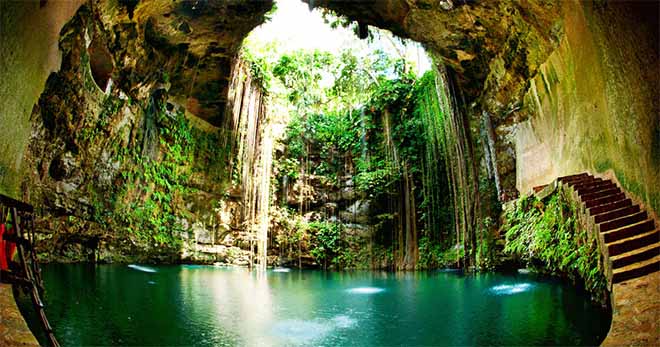Yucatan Peninsula Mayan Cenotes And Underwater Treasures

Many ancient civilizations developed alongside large rivers: the Nile for the Egyptians, the Euphrates for the Babylonians, the Indus for the Harappa civilization. In contrast, the Mayans did not have a river. The Yucatan is a peninsula without mountains and without surface water; the terrain is karst, limestone and porous; rainwater is quickly engulfed in the depths of the earth, creating networks of freshwater and abundant underground sources. This phenomenon was accentuated when a gigantic meteorite fell, approximately 65 million years ago, in the Caribbean Sea, causing the collapse of the relief at Yucatan and the appearance of cenotes. The Mayans considered cenotes to be sacred because they represented the possibility of surviving on inhospitable land.
Mayan Cenotes
Mayan Cenotes, which guaranteed life, made it possible to come into contact with the ancient gods who, according to the Mayan religion, lived in the underwater depths of Mother Earth. In the Yucatan peninsula alone, there are nearly 30,000 cenotes: some are easy to access, others are reserved for archaeologists only, and still others are unexplored. Many are linked together by an extraordinary network of caves, canals and underground lakes. The stalactites and stalagmites unite to form arrows or fully welded columns, evoking underground cathedrals.
The Mayans, who cultivated close ties with these caves, celebrated important ceremonies in their sacred waters. We owe the first reports on this subject to the writings of Bishop Diego de Landa; if he was on the one hand, responsible for the destruction of the Mayan writings - by causing the erasure of a large part of the history of which we could have known -, he left, on the other hand, the story of what he could observe directly: the bloody Mayan rituals. Physical pain was, for the Mayas, one of the means allowing them to come into contact with the divine: this is why they inflicted terrible injuries on themselves and once they entered in a trance, they threw themselves into the wells of the cenotes, ready to communicate with the gods. And we threw, still in the cenotes, priceless treasures, but also young people and drowned children, offered as a sacrifice.
Underwater treasures hunt

It was on the basis of these accounts that in 1904 American explorer Edward Herbert Thompson decided to go in search of the underwater treasures of the Mayan cenotes. He explored the ruins of Chichen Itza, one of the most representative centers of the Mayan empire, whose name precisely means: “at the edge of the Itza well”. Having found two mayan cenotes at Chichen Itza, Thompson decided to dive there with a rudimentary diving suit, namely a breathing tube and weights attached to shoes. He almost lost his hearing in this attempt, but he discovered, more than 40 meters deep, everything that the legend told: precious underwater treasures and terrifying skeletons, including children's skeletons. Thompson discovered what will be called the sacred cenote or the sacrificial cenote. Not far from there, he identified another mayan cenote, called Xtoloc, which, on the other hand, was used to supply the population with water. The cenote of sacrifices (the Sacred Cenote) has a diameter of about 60 meters and a depth of more than 80 meters; to access it, you have to jump 20 meters from the ground. Next to it stands an old building which was probably used for the purification ceremonies of the victims offered as a human sacrifice.
Today, a century after Thompson's courageous dive, yucatan mayan cenotes are still a challenge, even for the most experienced divers. The network of caves and galleries that connects them extends over at least 133 kilometers: an entire underground region largely unknown. These inaccessible caves still contain many hidden mayan treasures. Here, bones and offerings have been preserved for many centuries, discouraging the most relentless looters. Without doubt we will succeed in breaking through to date, with the technologies of the future, these true guardians of time that are mexico cenotes. They can then reveal the secrets of the Mayans and the knowledge lost at the stake of their manuscripts.









































































































































































































































































































































